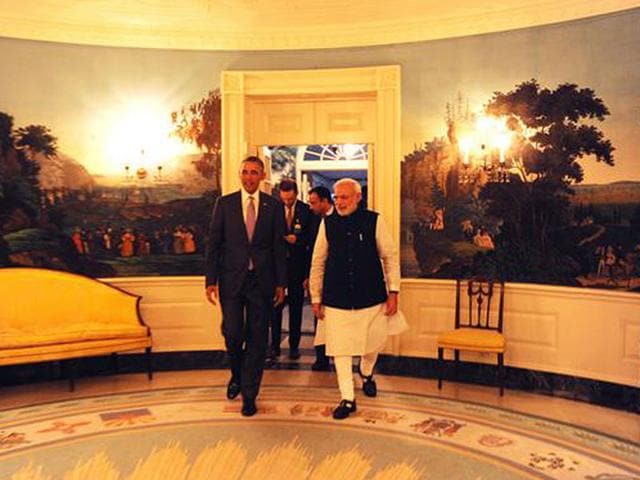Modi's engagement with US will yield substantial commitments
As long as the shadow of the nuclear deal dominates our perception of whether a summit is successful, we may continue to feel the relations are under-performing. And this mentality does not do justice to positive, transactional relations, writes Richard M Rossow.
While delivering a speech to the United Nations General Assembly is the ostensible reason for Prime Minister Narendra Modi’s visit to the United States, it will ultimately be its least important component.

Modi’s engagements with the business community, the Indian-American diaspora, and United States government will yield the most substantial commitments. Looking to Modi’s summit with US President Barack Obama, there is a powerful desire to see game-changing ‘deliverables’ stemming from these meetings.
In particular, at the back of everyone’s mind is whether we will announce another deal of the potential scale and significance of the civilian nuclear cooperation agreement.
The India-US civilian nuclear agreement, announced in July 2005, remains the high-water mark in our shared attempt to strengthen our strategic partnership. And, in two unfortunate ways, it continues to overshadow much of what has followed — including Modi’s summit with Obama.
First, there are expectations that every bilateral summit must have a nuclear deal, or risk being considered a failure. Second, India’s inability to fulfil the promise of civilian nuclear cooperation — through the passage in Parliament of a liability law which has precluded foreign commercial collaboration — has eroded trust in the senior levels of America’s policy establishment that India truly desires a stronger strategic partnership.
Measuring subsequent bilateral leadership summits against the civilian nuclear agreement poses a pair of obvious challenges. First, while there are plenty of deals that could potentially be announced and negotiated, few (if any) will have the impact of the civilian nuclear accord.
Examples of pending deals include the bilateral investment treaty, defence foundation agreements, the Commercial Space Launch Agreement (CSLA), and renewal of our Defense Framework Agreement.
A free trade agreement (FTA) is one potential deal which would match the civilian nuclear cooperation agreement, but there are high hurdles to launching FTA talks with India — in particular, the aforementioned concern among senior American policymakers about India’s ability to follow through on important strategic initiatives, and the fact that the US has its hands full with three major FTA talks already underway.
Second, we start this new phase in our relations with a great deal of accumulated distrust.
Unresolved commercial concerns on both sides of the ocean, to say nothing of the diplomatic incident in New York in December, have cast a dark cloud over the relations, which need to be repaired. And while the election of the new Indian government in May has offered a chance for a fresh start, New Delhi’s decision to block the WTO’s Trade Facilitation Agreement has brought many senior American policymakers to the conclusion that the new government is not such a dramatic change.
Looking back, the signing of the civilian nuclear cooperation agreement could be judged as a bit ahead of its time.
The leaders of both nations saw the significance of the relationship and attempted to lead from the front.
But apart from top leaders, neither side had developed deep relations with their counterparts, so the day-to-day workings of the relations since the July 2005 summit have not been as smooth as we may have hoped.
There is also a concern voiced frequently in Washington policy circles that our relations with India have “become too transactional”.
I actually believe transactional relations are a very positive step, and aligned with how Modi likes to conduct his affairs, as evidenced during his tenure as chief minister of Gujarat.
As noted earlier, we tried to jump-start a deeper strategic partnership by moving directly to cooperation in a deeply strategic sector.
If this “transactional” relation is coloured by the US offering cooperation in areas aligned with Modi’s interest, and the Indian government follows through on resultant commitments, this will provide important confidence-building measures.
A top-down approach to strategic cooperation did not meet either side’s expectations. A stronger bottom-up approach may work better.
There is no doubt that big-picture deliverables are important. They provide critical milestones against which we measure progress, and often challenge policymakers to move into uncharted territory — with resultant risks and rewards.
Deliverables that marry strategic and commercial interests are a potent combination towards boosting powerful, well-rounded relations between our nations.
Cooperation in areas such as civilian nuclear power, space exploration and defence carry particular significance.
But the constant comparisons — whether verbalised or not — to the July 2005 summit are unfair and unhelpful.
As long as the shadow of the nuclear deal dominates our perception of whether a summit is successful, we may continue to feel the relations are under-performing. And this mentality does not do justice to positive, transactional relations.
(Richard M Rossow is Wadhwani Chair in US India Policy Studies, The Center for Strategic and International Studies, Washington. The views expressed by the author are personal.)





